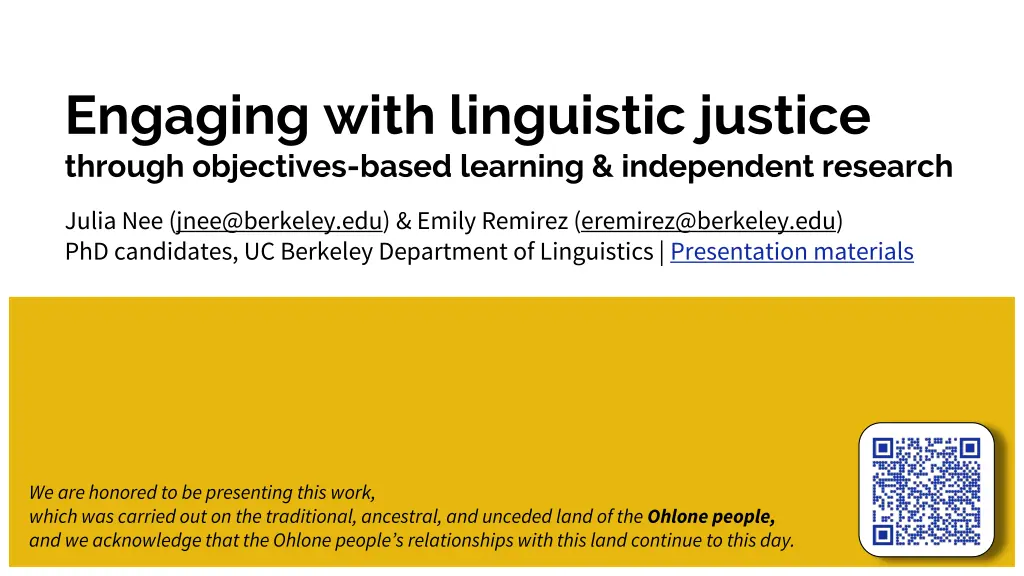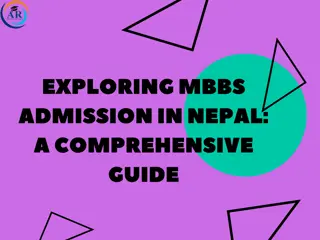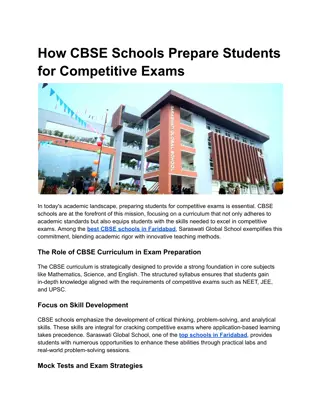
Engaging with Linguistic Justice: Objectives-Based Learning & Independent Research
Explore a transformative approach to linguistic justice through objectives-based learning and independent research. Join Julia Nee and Emily Remirez, UC Berkeley PhD candidates, as they delve into language, society, and empowerment in the US. Discover a supportive environment that fosters learner investment and inclusive education practices. Embrace a learning objectives-based framework that prioritizes student progress and mastery.
Download Presentation

Please find below an Image/Link to download the presentation.
The content on the website is provided AS IS for your information and personal use only. It may not be sold, licensed, or shared on other websites without obtaining consent from the author. If you encounter any issues during the download, it is possible that the publisher has removed the file from their server.
You are allowed to download the files provided on this website for personal or commercial use, subject to the condition that they are used lawfully. All files are the property of their respective owners.
The content on the website is provided AS IS for your information and personal use only. It may not be sold, licensed, or shared on other websites without obtaining consent from the author.
E N D
Presentation Transcript
Engaging with linguistic justice through objectives-based learning & independent research Julia Nee (jnee@berkeley.edu) & Emily Remirez (eremirez@berkeley.edu) PhD candidates, UC Berkeley Department of Linguistics | Presentation materials We are honored to be presenting this work, which was carried out on the traditional, ancestral, and unceded land of the Ohlone people, and we acknowledge that the Ohlone people s relationships with this land continue to this day.
Course overview: Language in the US Introductory course examining language and social structures (including race, gender, and class) in what is now known as the US (syllabus) Fulfills university American Cultures requirement No prerequisites; 41 students from a variety of majors Intensive 6-week summer course (2 synchronous hours/day, Monday-Friday) Course lecture & discussion with Julia Mondays through Thursdays Research methods & project development with Emily on Fridays Learning objectives for class meetings are submitted daily Flexible due dates & formats (recordings, short answers, discussion posts) Ability to re-submit multiple times Independent research project (assignment) Synthesized course material with students own experience & expertise Built up incrementally through milestones (1, 2, 3) with peer & instructor feedback
We wanted students to... Participate sincerely and constructively Feel respected, valued, and capable of success Develop robust investment as learners View themselves as not only consumers but constructors of knowledge Interrogate the way value is assigned to different types of knowledge Reflect on their own positions within systems of oppression Integrate course content with the realities of Summer 2020 Practice and acquire skills applicable beyond the classroom
The learner needs an environment that is supportive and accepting of students identities Learner investment (Norton Peirce 1995) A student may be a highly motivated learner, but may not be invested...if [classroom] practices are racist, sexist, or homophobic. (Darvin & Norton 2015)
Learning objectives-based framework* All assessments are formative, providing data that inform students progress Lowers stakes of any single assignment Encourages progress from any starting point Grading is transparentand reflects only student mastery Robust to circumstances beyond students control Ameliorates the effect of situational inequities on students grades Mistakes are central to the learning process Reduces fear of failure, increasing sincere participation Parallels the authentic and iterative process of research *Based on Grading for Equity (Feldman 2019)
Sample student output: Learning objective Learning objective: Explain the socially constructed nature of the concept of race in America by examining how individuals may be considered as belonging to different races depending on the social context. Sample submission Feedback Say more about racial categories have/haven't changed over time/space Second Submission: A Added connections to guest lectures from Profs Beth Piatote & Rich Rhodes and independent reading of Tommy Orange's There There First submission: C Incorporated sources explored in the course: art from the Tlacolulokos, reading of Garrett et al. (2018), course lecture about research ethics Result: Students connected ideas from inside & outside the classroom to provide personalized, nuanced reflections on difficult concepts
Sample student output: Learning objective Attitudes toward race certainly change over time, and we read earlier in this course that certain Indigenous individuals wanted to pass as White in California to escape that genocide thatbefelltheirgroups,fromGarrettetal. ... This was represented in Tommy Orange s novel There There One of his characters felt alienated fromIndigenouswaysof lifeduetohisurban lifeinOakland itwasimportant for the character to feel like he was valid in his interest in participating and learning more about the culture that did belong to him but was removed. This is similar to Professor Piatote s apprehension when playing with Nez Perce language, as she does not want to make a mistake and have the language stray too much from the way her ancestors might have used it.Ontheotherhand,itisherstoplaywithasa cultural andracialinheritance. ...race andbelongingcanbefluidindifferentspacesdependingonsocialpowerdynamics.
Sample student output: Research project Becoming American : Language loss within the Japanese American community during the early-to mid-20th century Other Topics: How has language around special education changed through multiple generators of educators? Question: Why did the Japanese Americans whose ancestors immigrated to the United States prior to World War II shift from speaking primarily Japanese to primarily English? Interviews with grandparents & mother, Japanese American National Museum collections, peer- reviewed research from class & independent literature search, personal reflection Japanese internment, pressure to assimilate, model minority myth and pan-Asian groupings How have attitudes toward being multilingual changed, and how does this interact with race and class? Sources: How have two generations of Armenian immigrants and Armenian Americans maintained ties to their language and culture? Themes:
Results & feedback Classroom environment allowed students to feel: Respected(21/21 respondents strongly agreed) Included(17/21 respondents strongly agreed, 2 somewhat agreed, 1 somewhat disagreed, 1 NA) Flexible deadlines promoted learning: I liked how she was flexible with deadlines...due to technological issues, pandemic-related mental health crises, taking care of younger sibling, etc., I missed almost every deadline, but I was still able to learnand get feedback on my work. It really encouraged me to learnand catch up on assignments whenever I fell behind. Students had authentic and independent experiences 23/26 felt more prepared to take on research projectsin the future 23/26 felt they practiced skills they can use in the future [Emily] was very enthusiastic about our project ideas and the final project was open enough that we could do our own research on whatever we found interesting which made it much more independentthan following a prompt
Results & feedback Students engaged with feedback and resubmissions: 21/21 agreed that they feel comfortable incorporating feedback and resubmitting Normally when I turn in an assignment, I don t necessarily expect a thoughtful reply and comment that shows that the instructor took their time to read and understand what the student is thinking about. I really got this sense of carefrom this course staff. I tended to write a lote in my assignments and despite this, each and every single one had a thoughtful comment...this really encouraged me to finish the assignments and learnthe material. I was always well aware of what was expected of me and how to reach out for help. Room for improvement: Integration between research projects in discussion section and lecture Normalization of resubmitting & refining rather than duplicating work Effective modes of interaction in virtual environment: Stable discussion groups with the same folks Groups of 3-5 rather than pairs
And thanks to Generous guest speakers* Victoria Robinson & the UC Berkeley American Cultures Program for providing feedback & funding Thank you! Questions? Email us at jnee@berkeley.edu eremirez@berkeley.edu Prof Andrew Garrett for supporting course staff through the challenging summer term Prof Richard Rhodes & Raksit T. Lau- Preechathammarach for sharing resources and wisdom from past iterations of the course *guests included Isaac Bleaman, Roslyn Burns, Kristin Foringer, Leanne Hinton, Aurora Martinez Kane, Sharese King, Edwin Ko, Vincent Medina, Beth Piatote, Louis Trevino, & Eric Wilbanks. Our wonderful students!










